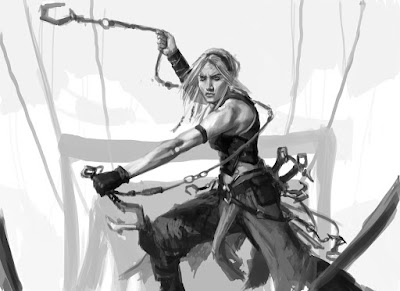So, Lantern Scout. Yeah. Not a lot of controversy, not a hugely difficult process, and not a lot of issues along the way. In fact, it was about as straightforward as things go. As always, it began with an art order:
ART DESCRIPTION:
Setting: ZENDIKAR
Color: White creature
Location: Guul Draz
Action: Show us a female human scout moving through a murky geyser field in Guul Draz. She has a short sword in one hand and a glowing hedron-lantern in the other, lighting her way through the swamp. Behind her, we can make out the shapes of two other humans following her light--perhaps only indistinctly through the steam of Guul Draz.
Focus: The scout with the lantern.
Mood: She's a light shining in the darkness.
As luck would have it, the same day I got my assignment, I had a model over for an unrelated project. At the tail end of our session, however, I took the opportunity to take a bunch of shots of her holding a lamp to try and nail down the scene for the painting that lay ahead. This was the opposite of how things typically go, mind you, since I normally do at least a thumbnail sketch before committing to shooting reference. But taking the photos felt worthwhile—especially if they prevented me from having to paint myself yet again.
 |
| Model: Éowyn Rose |
Not surprisingly, I could have used the game plan that a sketch would have provided. As I explored the scene in sketch form, it became clear to me that the photos I shot with the model would end up being less helpful than I'd hoped, and so I lit the scene and struck a pose and then used my maul stick to pull the trigger on the Photo Booth App (ahhh, technology).
 |
| Model: Paintermonkey |
The end result was sort of a melding of both bits of reference along with a bunch more stuff thrown in (thank you Google Images). Anyway, this is the sketch that resulted:
 |
| ©Wizards of the Coast |
And here is the finished piece:
 |
| ©Wizards of the Coast |
While I stated above that the creation of this piece was pretty straightforward, there was one thing that did cause a bit of a hiccup. While painting the piece, I failed to step back often enough and take the piece in from afar. The result of this negligence was that the scout's proportions became slightly off. As soon as I digitized the piece and was able to reduce it at will in Photoshop, it became quite obvious. So I ended up tweaking things in Photoshop before submitting the piece. After that, I spent an additional day working on the painting to get it to match the digital file. Mind you, the necessary tweaking wasn't a big deal, but I admit that I was a little irritated with myself because I knew better. Or thought I did.
Still, aside from that small, last-minute issue, the piece was about as straightforward as I could make it and it ended up being one of my favorite pieces I painted in 2014. If nothing else, I managed to nail the mood I was going for, and I was quite pleased with the more limited palette I went with to get there.
So yeah, another one that I don't hate. What is happening to me?















































